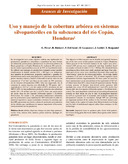| dc.contributor.author | Pérez, E. | |
| dc.contributor.author | Richers, B. | |
| dc.contributor.author | DeClerck, E. | |
| dc.contributor.author | Casanoves, Fernando | |
| dc.contributor.author | Gobbi, J. | |
| dc.contributor.author | Benjamin, Tamara | |
| dc.date.accessioned | 2015-03-19T22:14:32Z | |
| dc.date.available | 2015-03-19T22:14:32Z | |
| dc.date.issued | 2011 | |
| dc.identifier | 487846 | es_ES |
| dc.identifier.issn | 1022-7482 | es_ES |
| dc.identifier.uri | https://repositorio.catie.ac.cr/handle/11554/6895 | |
| dc.description.abstract | La investigación tuvo como objetivo realizar una tipificación de productores ganaderos e identificar y cuantificar los usos, formas de utilización, preferencias y limitantes de la cobertura arbórea en fincas ganaderas en Copán, Honduras. Se realizaron 101 entrevistas, las cuales representaban cerca de un 30% de la población total. Se elaboró una tipología de productores tomando como variable clasificatoria la unidad animal (UA = 400 kg) y se definieron tres tamaños de productores: pequeños, medianos y grandes. Se identificaron cuatro usos principales de la cobertura arbórea: leña, postes muertos, estacas y madera. Sobresalió el uso de leña con un consumo de 17 m3 año-1 por finca, de los cuales un 70% proviene de los sistemas silvopastoriles (SSP). Otro uso importante fue el consumo de postes muertos con alrededor de 256 postes año-1, equivalentes a 28,5 m3 y de los cuales el 80% provienen de los SSP. El 69% de los productores prefieren potreros con cobertura media (30 a 40 árboles por ha) y el 62% tiene una preferencia de cercas vivas de dos especies (Gliricidia sepium y Erythrina berteroana). En cuanto a las principales limitaciones señaladas por los productores para implementar SSP sobresalen la falta de material vegetativo y apoyo económico y técnico. Se concluye que los SSP representan una fuente valiosa de productos provenientes de los árboles que contribuyen de manera importante al bienestar socioeconómico de los ganaderos. | es_ES |
| dc.description.abstract | The objective of this research was to identify and quantify farmers use of the tree cover within pasture systems in Copan, Honduras. Thirty percent of the livestock farmers in the region were interviewed (101 surveys were conducted) and thus stratified based on number of head of cattle (1 UA = 400 kg). We classified farms according to three farm sizes: small, medium and large. Four principal uses of tree cover were identified: firewood, fence posts for “dead fences”, posts for live fences and timber. An average family consumes 17 m3 year-1 of firewood, 70% of which originates from silvopastoral systems. Approximately 250 fence posts are used for fence maintenance on an annual basis of the equivalent of 28.5 m3, of which more than 80% comes from silvopastoral systems. Nearly seventy percent of farmers interviewed prefer pastures with medium tree cover (30-40 individuals ha-1) and 62% prefer live fences with two tree species (Gliricidia sepium y Erythrina berteroana). The most important restrictions to increasing silvopastoral systems on their farms are due to lack of propagation material as well as a general lack of economic and technical support for silvopastoral systems. In conclusion, though SPS are providing an important portion of the welfare to the livestock farmers and their family in the region of Copán, their full potential is not being met for lack of institutional support rather than resistance to the technology. | en_EN |
| dc.format.mimetype | pdf | |
| dc.language.iso | es | es_ES |
| dc.publisher | CATIE, Turrialba (Costa Rica) | es_ES |
| dc.relation.ispartof | Agroforestería en las Américas, número 48 (2011) | |
| dc.rights.uri | https://creativecommons.org/licenses/by-nc-nd/4.0/ | |
| dc.subject | GLIRICIDIA SEPIUM | es_ES |
| dc.subject | ERYTHRINA BERTEROANA | es_ES |
| dc.subject | EXPLOTACIONES GANADERAS | es_ES |
| dc.subject | CUBIERTA DE COPAS | es_ES |
| dc.subject | MADERA | es_ES |
| dc.subject | LEÑA | es_ES |
| dc.subject | POSTES | es_ES |
| dc.subject | ESTACAS | es_ES |
| dc.subject | PRODUCTOS FORESTALES | es_ES |
| dc.subject | PRODUCTOS FORESTALES NO LEÑOSOS | es_ES |
| dc.subject | SISTEMAS SILVOPASCICOLAS | es_ES |
| dc.subject | CUENCAS HIDROGRAFICAS | es_ES |
| dc.subject | RIO COPAN | es_ES |
| dc.title | Uso y manejo de la cobertura arbórea en sistemas silvopastoriles en la subcuenca del río Copán, Honduras | es_ES |
| dc.type | Artículo | es_ES |
| dc.identifier.publisher | Centro Agronómico Tripical de Investigación y Enseñanza | es_ES |
| dc.journal.issueNumber | 48 | |
| dc.journal.pages | 26-35 | |



